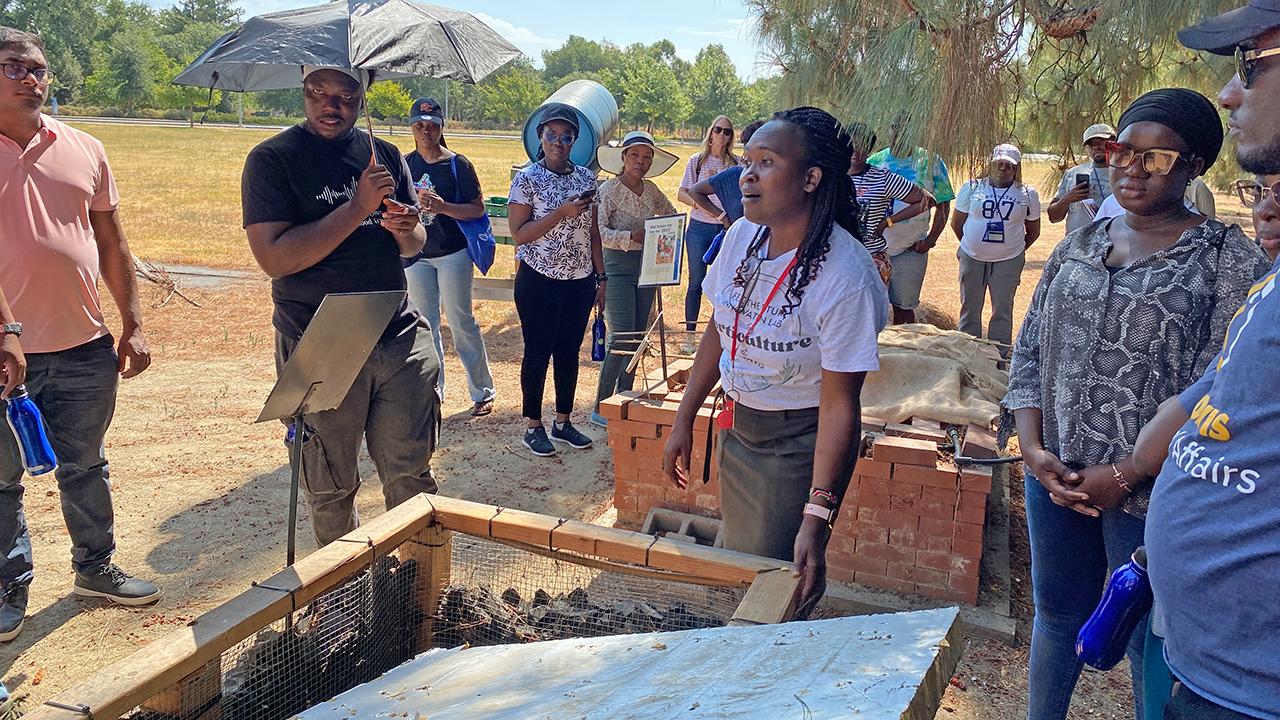
“Accessible tech” sparks inspiration in Feed the Future garden
Mandela Washington fellows network while learning innovative ag practices

Half of the fresh fruits and vegetables grown in developing countries never get eaten: They spoil after harvest.
In a rustic-looking garden on the UC Davis campus recently, two dozen young leaders from sub-Saharan Africa viewed simple, low-cost innovations that can reduce postharvest losses, increase food safety and preserve nutritious food in their home countries.
Program Officer Lydiah Maranga shepherded the visitors from the postharvest technologies to raised beds growing indigenous vegetables to fruit trees on a hot, sunny day outside the offices of Feed the Future Innovation Lab for Horticulture. The materials for each technology, she explained, can be adapted to leverage cheap and handy materials available locally, making them viable for small-scale farmers and producers. Such innovations can help those farmers diversify their crops, boost their incomes and offer families greater health.
A few of the technologies on display:
- A relatively low-cost, solar-powered cold room using an ordinary air conditioning unit can cool fruits and vegetables at optimal temperatures for storage between harvest and market, increasing their shelf life. The key technology is a CoolBot device that overrides the temperature control on a standard home air conditioning unit, allowing it to cool a room to as low as 32 degree Fahrenheit. Further research is on-going in local universities to find solutions to build an even more cost-effective cold room.
- The charcoal cool room is a wood-framed box; its chicken-wire walls are filled charcoal and topped with reflective, insulated material. Irrigation drip lines keep the charcoal wet: Using simple evaporation and no electricity, the box keeps produce cool.
- The solar chimney dryer can be built with locally available materials to safely and efficiently dry fruits and vegetables, extending by months their marketability and availability for consumption.

“Our work seeks to showcase UC Davis's research contributions to address challenges in global food systems,” Maranga said. “We are excited to engage with the visitors and their curiosity about the innovations we have and how that can make a difference in their own communities.”
Feed the Future Innovation Lab for Horticulture is part of a global research network that promotes local leadership and social and economic progress through agriculture. The visitors were part of the Mandela Washington Fellowship for Young African Leaders, hosted by UC Davis Global Affairs. The fellowship’s goal is to boost the knowledge and leadership of rising young Africans and equip them to make even greater contributions back home.
“Inspiration and insight” for transforming agriculture
The low-cost postharvest technologies in the Horticulture Innovation Lab Demonstration Center garden are being tried out in a range of locations, including Kenya, Uganda, Ghana and Tanzania in Africa; Honduras and Guatemala in Central America; and Nepal in Southeast Asia. Researchers are looking at how each performs at various ambient temperatures and humidity levels.
Flowers and herbs, after harvest, also can be handled with these methods. Those specialty crops, when added to traditional farming products, can grow farmers’ income, the visitors learned.
The experience has been stimulating, and the connections the visitors are making are sparking ideas for the future, they said.

“I’m here to get exposure to the different sustainable practices in agriculture that I can take home,” said Tapiwa Motshweneng, from the Republic of Botswana in southern Africa. She wants to learn best practices, network, form partnerships and find opportunities for collaboration. Her goal is to contribute toward transforming agriculture in a nation where the Kalahari Desert makes up 70 percent of its territory.
Yves Kaguriro works with small-scale farmers in the Democratic Republic of the Congo, in central Africa. People there have struggled to produce food amid decades of war and political instability, after an extractive colonial experience based on mining.
“Many farmers are losing produce after harvesting, which should not be the case,” Kaguriro said, looking around at the garden. “This is very easy technology… I’m getting inspiration and insights from this fellowship.”
Related links
The Feed the Future Innovation Lab for Horticulture, directed by Erin McGuire, is based at UC Davis and housed in the Department of Plant Sciences. Funding comes from the United States Agency for International Development, with the aim of empowering small-scale producers to earn more income and better nourish their families and communities.
Read more about low-tech solutions for reducing postharvest losses in this article by Archie Jarman, associate director, and others from the Feed the Future Innovation Lab for Horticulture: “Postharvest technologies for small-scale farmers in low- and middle-income countries: A call to action.” (2023). In Postharvest Biology and Technology (Vol. 206, p. 112491).
More about the Mandela Washington Fellowship for Young African Leaders.

Media Resources
- Feed the Future Innovation Lab for Horticulture contributed to this article.
- Trina Kleist, UC Davis Department of Plant Sciences, tkleist@ucdavis.edu, (530) 754-6148 or (530) 601-6846
